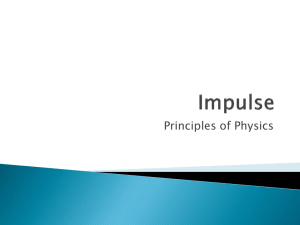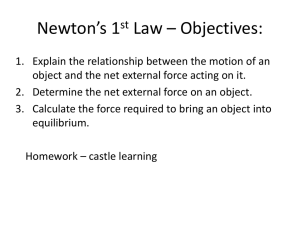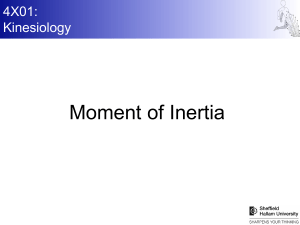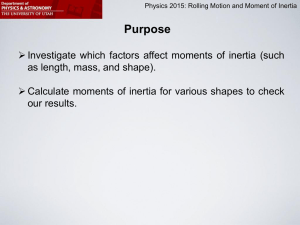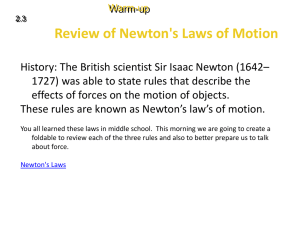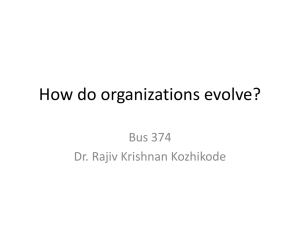Lesson 3: Newton`s First Law
advertisement
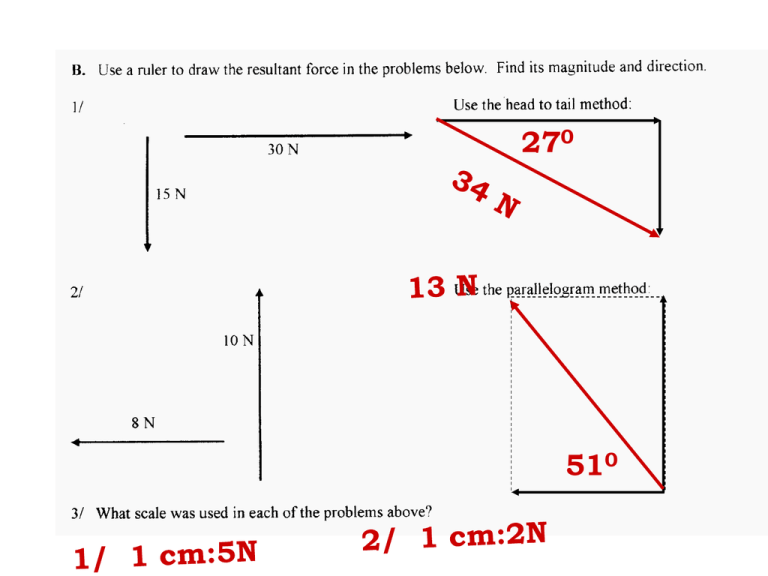
270 510 1 cm:10 N 1 cm:4 N 1 cm:8 N 1 cm:3 N Newton’s 1st Law of Motion: If the ____________________ force, Fnet, acting net (resultant) zero on an object equals ________, then that object has 0 . ____________________ constant velocity . Its acceleration a = _____ equilibrium It is said to be in __________________ . vectors Because forces are ______________ and have direction , the x and y _______________ components of the ____________ separately forces often must be added up _______________ when there are forces along different _________. axes Fnet = 0 really means: net Fx = 0 ________ net Fy = 0 ________ Ex: A 20-N box on a table at rest Free body diagrams: FN = 20N 20-N w = FN "At rest" __________ w = 20 N Ex: A 20-N box at rest on a table being pushed down with a 5 N force. FN = 25 N 5-N 20-N w + push = FN "At rest" _______________ 5N w = 20 N Both of these boxes are in ___________________ . equilibrium Ex: Same box sliding to the right on a horizontal frictionless table at a constant velocity 2.0 m/s v = 2.0 m/s FN = 20N 20-N w = FN "constant velocity" __________ w = 20N velocities Draw only the __________ forces , not the ____________ Notice: same 1/ The free body diagram is the _________ as the equilibrium first example. Both are in ___________________ . needed to keep box moving. 2/ No force is ___________ forever The box will continue its motion ________________. Ex: The forces acting on a 20-N box are shown at right: Ff = 10 N FN = 20N pull = 10N w = 20 N equilibrium This box is in ___________________. It is either: at rest 0 1/ _____________ (constant velocity = _____); moving 2/ or _____________ at a constant velocity. Unless other information is given, it is impossible _______________ to tell if it is at rest or moving. Ex. The three forces below are the only ones acting on an 2.0-kg object. What is the acceleration of the object? Add them up: 3.0 N 4.0 N 5.0 N 3.0 N 4.0 N 0 so a must = ____ 0 . The net force Fnet = _____ at rest This object could be _______________ or constant velocity moving with ____________________________ . Restatement of 1st Law: at rest or moving with If an object is ____________ constant velocity in equilibrium _____________________, it is_________________. =0 Then the net force (Fnet ) acting on it _________ . Ex: A B-2 bomber flying at constant velocity: weight ≈ 1.3 x 106 N thrust ≈ 75 x 103 N/engine x 4 engines lift = 1.3 MN Ff (drag) = 300 kN thrust = 300 kN w= 1.3 MN The “air force” Ex. The two forces shown below act on an object. What third force is needed to produce equilibrium? F1 F2 First way to solve: • Find resultant force F • The answer is -F: F -F balances -F ___________________ the other two forces. Second way to solve: 1. Add the two forces using head to tail method. 2. Add a force to "bring the total force to zero." F1 head to tail: original F1 F2 F2 -F Notice: the same result • Both ways give ________________________ resultant • -F is NOT the ________________ of the other "balances out" vectors. It is the force that ________________ the other vectors, making Fnet =________. It is 0 sometimes called the ________________ because it equilibrant is what is needed to produce ___________________ . equilibrium Ex. Draw the vector that represents the force that the beam exerts on point A. beam force building T A beam weight A w equilibrant The beam force is the ________________ . It must Fnet = 0 be added to the other forces so that ___________ Ex. Increasing angle between 2 wires supporting a picture: Case 1: vertical wires 1 1 2 5 T = ____ in each wire 2 10 N w = 10 N Case 2: greater angle 2 1 2 1 10 N 7 T = ____ in each wire w = 10 N Case 3: even greater angle 1 10 N 2 1 2 w = 10 N increases As q increases, the tension _______________ . 10 T = ____ in each wire Ex. What has more inertia, a truck or a baseball? truck more __________ mass inertia more___________ inertia not needed to maintain A net force is ________________ motion. An object will maintain its motion in absence the ________________ of a net force. This idea Galileo was discovered by _____________. An object in stay in motion motion tends to ____________________ , and an stay at rest object at rest tends to _________________ . The property of matter _______________________ that “makes” this true is called its ___________ inertia . mass Inertia is the tendency of an object to resist changes in motion . More inertia (mass) _________________________ means it is __________________ for an object to… more difficult 1/ …_____________________ when it is at rest; start moving 2/ … __________ when it is already moving; and, stop move sideways 3/ … ____________________ from a straight path. inertia In other words, ______________ is why an object no net force needs __________________ equilibrium to maintain its motion. This is why Newton's Law st 1 Law of _____________ is called Inertia Law of Inertia . the ________________ a F net =0 =0 Open your 3-ring binder to the Worksheet Table of Contents. Record the title of the worksheet: Newton’s First Law WS
